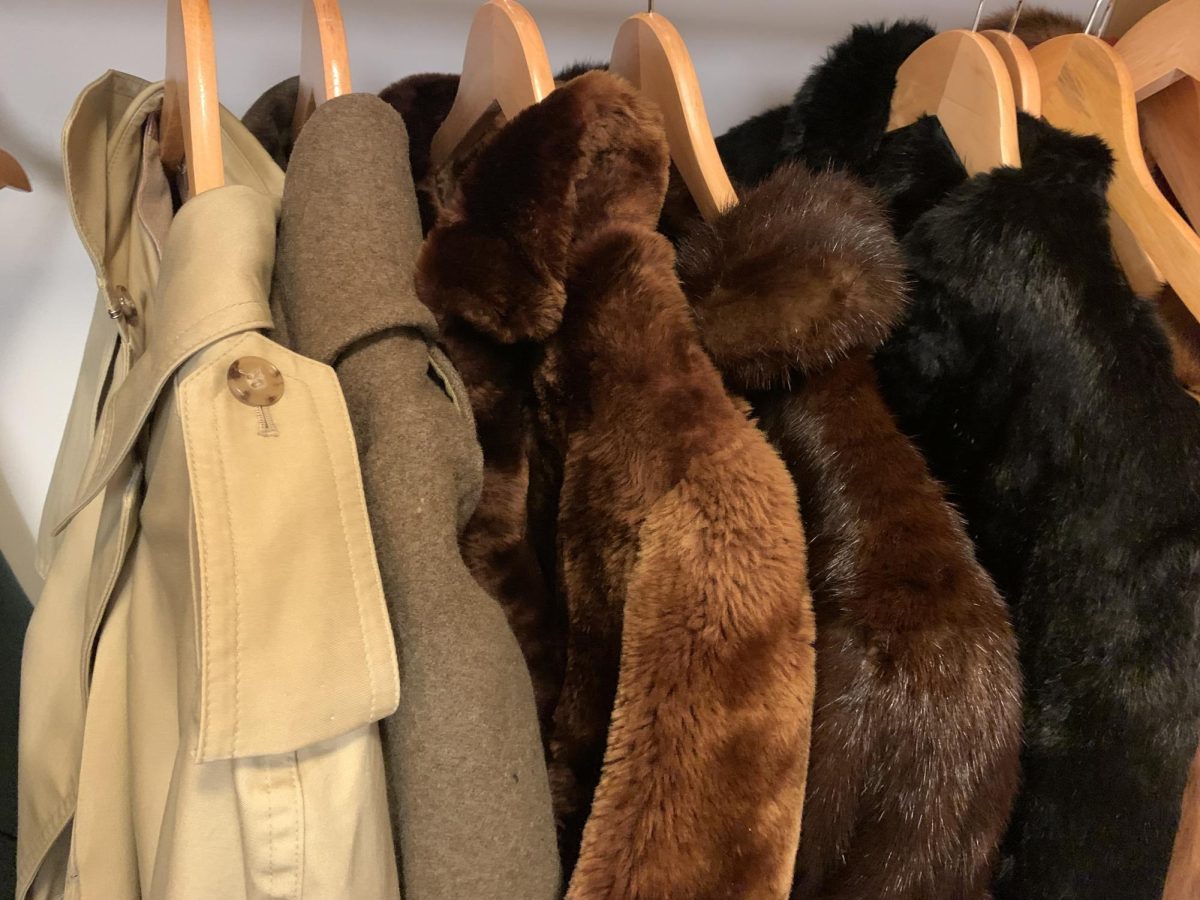The handle of the brown paper bag pinches into my skin as I hike up the hill from downtown back to campus. Inside the bag is one of the additions to my growing collection of coats. Inspired by style icons such as Cruella de Vil, Russian literature such as “Doctor Zhivago” and “Anna Karenina” and mid-century fashion, furs and long overcoats are a long-standing fascination of mine. Sure, a down jacket might be more practical, but why would I want to trudge around feeling like a marshmallow or the Michelin Man when I could walk around looking like Lara from “Doctor Zhivago?” My collection of outerwear is vast. However, to keep this article short I’m only going to talk about coats, not jackets. A coat, as I define it, is a piece of outerwear that is hip length or longer.
The first of the coats is a trench coat I found in a thrift store for about $10. The coat is a light beige color with the slightest tint of green and has a plaid lining. The sleeves are slightly too long for my arms and the straps that are supposed to tighten the sleeves never quite work as they should. This was my first thrifted overcoat. Although it isn’t as thick or hardy as my green wool coat or my furs, it’s sufficient for a slightly brisk fall or chilly winter day. From what I can tell of the coat, it looks like it was made in the 80s or 90s, as it has the boxy and bulky look characteristic of coats of that era. What I love about this coat is that it’s very accommodating of more layers underneath. A detail I dislike about modern trench coats is that they seem to be made with a sleek look in mind. There aren’t supposed to be many layers underneath; at the most, they can probably accommodate a thin sweater . Such a look might be more fashionable, but I wouldn’t say that they’re better than older models of trench coats. I’d even dare say they’re worse, because such a coat is practically useless in the cold.
Now onto the heavier coats. Still starting off light, there’s my green wool coat with the most wonderful peaked lapels and buttons imprinted with the seal of the United States. The coat was made in 1943, originally for a soldier in World War II. The wool is heavy and, best of all, it’s quite accommodating of layers. I have to say I prefer this coat over the trench coat because of the fit and style. The sleeves aren’t too long or too short, and it almost looks as if it were perfectly tailored for my measurements. Also, as a lover of mid-century style, this is a perfect addition to my collection, without looking too old-fashioned when I want to dress more modern. This coat is probably the most versatile out of my collection. It’s good in both the 50s and subzeros. As someone who loves to wear longer skirts, I love how this coat sits perfectly at or slightly below the hem. What’s absolutely amazing about this coat is that it is more than 80 years old and it still looks perfectly new — not to mention that it’s unlikely to find coats completely made out of wool or with the same thickness of material nowadays. Even if one does find a coat of comparable quality, it will likely cost hundreds, if not thousands, of dollars.
Now, onto the most interesting — if not controversial section — of my collection… the furs. The first fur coat in my collection is a beaver coat. The coat is a dark brown, but depending how it’s positioned in the light, the hairs appear a golden color. There are two large brown buttons for the closures and a hook and eye towards the collar. The coat, if I am honest, is beginning to fall apart. The buttons have recently been slipping off. I’ve had to resew them and add new closures. The lining seams are also starting to rip. Bits of the fur on the sleeve cuffs are starting to clump together and look a bit dull. To be fair, this coat is probably more than 70 years old. Despite all the signs of disrepair, the coat is a great addition to my collection. I’ve worn it in the past few weeks in temperatures as low as -12°F, (and while traying), without feeling like I’m going to freeze to death. As someone who cares a lot about materials, fur is one of the best to have in my collection. Fur is durable, insulating and timeless. Fur has been a staple in winter wardrobes for millenia because of its insulation qualities. The hairs in a fur coat are hollow, so they trap air to prevent your body heat from being released into the external environment. Also, a real fur coat is basically a leather jacket with the hair still attached, whereas faux fur is fabric with tufts of fake hair attached to it. Try as they might, a synthetic fur can never compare to a real fur coat in insulation qualities and timelessness.
Finally, onto the newest addition to my collection. The coat is made of mink and dates back to the 1940s. Despite its age, the coat looks practically brand new. The hairs are a darker brown than the beaver coat and they don’t appear gold when you shift it in the light. There aren’t any large buttons on this coat. However, there are more closures and, thankfully, they reach up to my neck. The mink isn’t as thick as the beaver, and I haven’t worn it in negative temperatures yet. However, I’m confident that it will hold up just as well if not better than the beaver.










